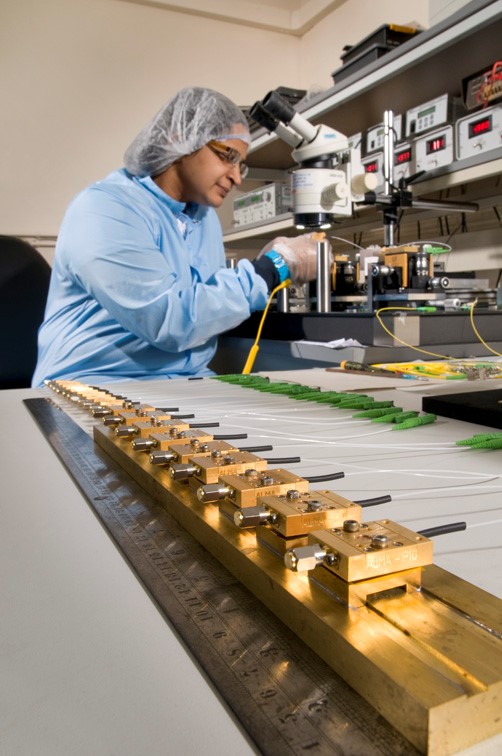Photomixing, or optical heterodyning, generates millimetre wave to terahertz frequency radiation by beating two laser beams in photodiode or photoconductor. The approach used in RAL Space takes advantage of telecoms technology, and uses circa 1550 nm light in conjunction with ultrafast photodiodes developed for high frequency, wide bandwidth, and data links. The light enters along a standard single mode optical fibre and the generated millimetre wave signal appears in a rectangular waveguide. Specialised engineering approaches couple the generated power from the µm scale photodiode to the output waveguide, and maintain the fibre in good alignment with the photodiode. Different designs of photomixer are used to generate signals between 30 GHz and 1.2 THz. Highest output powers are of order of 200 µW at low frequencies, dropping to around 100 nW at 600 GHz, for optical input powers of around 10 mW.
 RAL Space's photomixers underpin the operation of the ALMA radio telescope. Several hundred devices, produced under contract with European Southern Observatory (ESO), are operating in the Atacama desert to provide the critical phase locking signal for the array's astronomical receivers. Our photomixers are also employed in the highly stable laser systems used to generate the clock signals for the array, a signal which is then distributed over up to several km of optical fibre to the individual antennas. We are currently working with the Academia Sinica Institute of Astronomy and Astrophysics, Taiwan, to prototype lower frequency photomixers for ALMA. We have previously worked with IRAM, France, to use photomixer signals as the local oscillator of an astronomical receiver at 160 GHz.
RAL Space's photomixers underpin the operation of the ALMA radio telescope. Several hundred devices, produced under contract with European Southern Observatory (ESO), are operating in the Atacama desert to provide the critical phase locking signal for the array's astronomical receivers. Our photomixers are also employed in the highly stable laser systems used to generate the clock signals for the array, a signal which is then distributed over up to several km of optical fibre to the individual antennas. We are currently working with the Academia Sinica Institute of Astronomy and Astrophysics, Taiwan, to prototype lower frequency photomixers for ALMA. We have previously worked with IRAM, France, to use photomixer signals as the local oscillator of an astronomical receiver at 160 GHz.
Photomixing in general offers significant advantages when distributing the local oscillator signals for heterodyne receiver arrays. We are currently working with University College London, and ESA to develop and test a high power 100 GHz photomixer, suitable as a transmitter and the local oscillator for a Schottky diode based heterodyne receiver. Our extensive experience with photomixers means that we can offer a package and fibre alignment services to academia and industry.
Cleanroom photomixer production in volume for the ALMA radio telescope.
For more information please contact: RAL Space Enquiries
